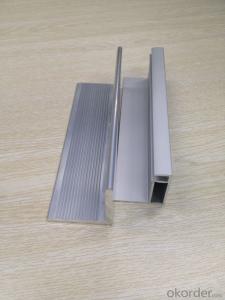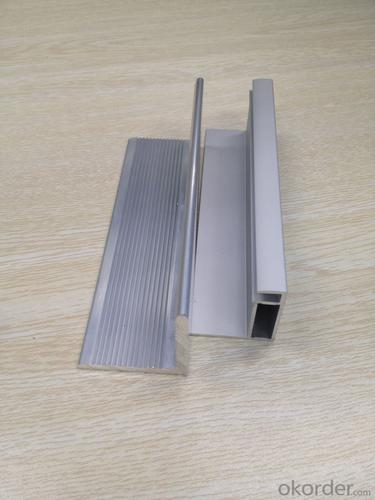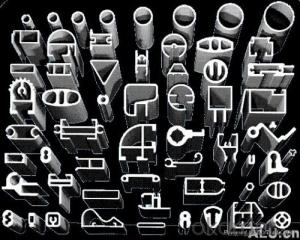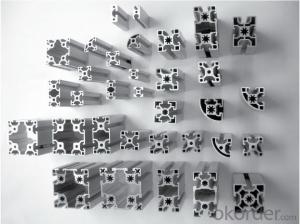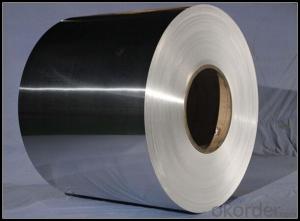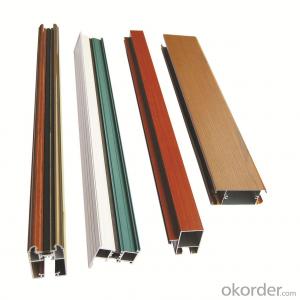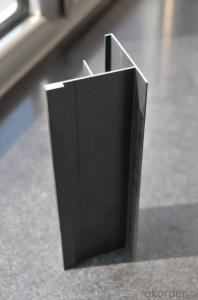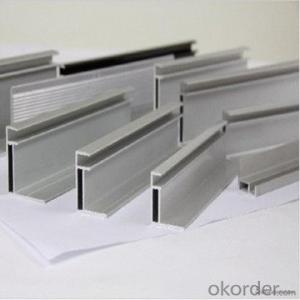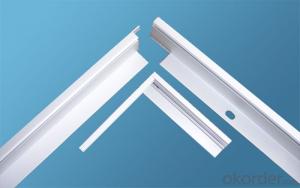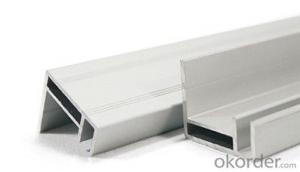Aluminum Angle Profiles for Solar Module Structure
OKorder Service Pledge
OKorder Financial Service
You Might Also Like
We are the largest aluminum profilemanufacture in
Provide full type of solar module frame:
Size:30x25mm
35x35mm
35x40mm
Other size can be accepted.
Material | Alloy Aluminum 6063,6061,6005,6082 or customer nominated |
Temper | T3, T4, T5, T6 and other |
Surface | Anodize, electrophoresis, powder coating, PVDF coating, wood grain painting, etc. |
Colour | Any colour based on Standard Germany RAL Mark |
Length | Not more than 16 meters |
Good Package | Inner plastic film /outside carton/wooden pallets |
Payment Method | T/T, L/C, etc |
Delivery Time | Normally 2-4 weeks, Delivery time can be consulted. |
Press Machine | 500-12500 tons all together 93 press lines. |
Fabrication | 1. Solar module frame; 2. Drilling; 3. Bending; 4. Cutting; 5. etc. |
Certificate | ISO/TS 16949,DNV,IRIS,CCS,AFA,etc. |
Dies | 1. Using our dies, no fee; |
2. Using customer drawing, opening dies, usually about 5~50 tons then the dies cost can be refunded. | |
3. Die cost is negotiable base on the order quantity | |
Capability | Annual output 800,000 tons |
- Q: Can aluminum profiles be used in the production of agricultural equipment?
- Aluminum profiles have the potential to be utilized in the manufacturing of agricultural equipment. The versatility and lightweight characteristics of aluminum provide numerous benefits for agricultural applications. Its resistance to corrosion is crucial when considering equipment that is exposed to outdoor conditions and various farming chemicals. Moreover, aluminum profiles have the capability to be easily molded and customized to meet specific design requirements, enabling the creation of intricate and functional agricultural equipment. The lightweight nature of aluminum also simplifies the transportation and handling of the equipment, resulting in reduced labor costs. Additionally, aluminum profiles are recyclable, making them an environmentally conscious choice for the production of agricultural equipment. In conclusion, incorporating aluminum profiles into agricultural equipment can enhance durability, efficiency, and sustainability within the farming industry.
- Q: What are the various finishes or coatings that can be applied to aluminum profiles to enhance their appearance, durability, or functionality?
- <p>Aluminum profiles can be coated with a variety of options to improve their aesthetic appeal, corrosion resistance, and performance. These include anodizing, which creates a protective oxide layer; powder coating, offering a wide range of colors and textures; electrophoretic coating, known for its smooth finish; and thermal spraying, which involves applying a coating through a high-velocity flame. Other options are painting, which can be done in various colors, and polishing, which gives a shiny finish. Each coating option has its specific benefits and applications, depending on the requirements of the project.</p>
- Q: The aluminum panel is the cart, ordinary nylon plate, the wheel is not conductive wheel, why use aluminum surface will be static, but not in the nylon plate, not easy to produce electrostatic in high resistance material?
- Electrostatic powder spraying on aluminum surface is not to prevent static electricity, it is to use the static electricity to spray the powder on the surface of the aluminum.
- Q: Can aluminum profiles be used for window frames?
- Yes, aluminum profiles can be used for window frames. Aluminum is a popular material choice for window frames due to its durability, strength, and resistance to corrosion. It is lightweight, easy to shape, and can withstand various weather conditions, making it a suitable option for window frames. Additionally, aluminum profiles can be customized to fit different window sizes and designs, making them a versatile choice.
- Q: Are aluminum profiles suitable for high-temperature environments?
- Aluminum profiles are generally not suitable for high-temperature environments. While aluminum has excellent thermal conductivity and is a lightweight material, it has a relatively low melting point compared to other metals. Aluminum begins to soften at temperatures above 400°C (752°F) and can lose its structural integrity at higher temperatures. In high-temperature environments, aluminum profiles may experience deformation, distortion, or even complete failure. This can compromise the stability and functionality of any structure or system relying on aluminum profiles. However, there are certain types of aluminum alloys that are specifically designed to withstand higher temperatures. These alloys, such as 6061 and 7075, have improved heat resistance and can tolerate higher temperatures without significant damage. These specialized alloys are commonly used in applications requiring higher temperature resistance, such as aerospace components or certain industrial processes. Nevertheless, it is crucial to carefully consider the specific temperature requirements of a given environment before using aluminum profiles. In extreme high-temperature environments, other materials like steel or refractory metals may be more suitable due to their higher melting points and superior heat resistance properties.
- Q: Are aluminum profiles suitable for use in exterior wall insulation systems?
- <p>Yes, aluminum profiles can be used for exterior wall insulation systems. They are known for their durability, resistance to corrosion, and ability to withstand various weather conditions. Aluminum profiles provide a strong structural framework that can support insulation materials effectively. They are also lightweight, which makes them easy to handle and install. Additionally, aluminum profiles can be anodized or coated to enhance their resistance to environmental factors, making them a popular choice for exterior insulation systems.</p>
- Q: How do aluminum profiles perform in electrical insulation applications?
- Aluminum profiles generally do not perform well in electrical insulation applications. Unlike materials such as plastic or rubber, aluminum is a conductor of electricity and does not possess the insulating properties required to prevent the flow of electric current. Therefore, using aluminum profiles in electrical insulation applications can pose significant risks, such as the risk of electric shock or short circuits. It is essential to choose materials specifically designed for electrical insulation purposes, such as insulating plastics or rubber, to ensure the safety and effectiveness of electrical systems.
- Q: Can aluminum profiles be used for signage?
- Signage can indeed utilize aluminum profiles. Aluminum, a material known for its versatility and durability, is commonly utilized in various signage applications. It boasts numerous advantages, including its lightweight nature, resistance to corrosion, and ease of manipulation. Aluminum profiles can be effortlessly shaped into diverse forms and sizes, rendering them suitable for a vast array of signage needs. Furthermore, these profiles can be powder coated or painted to attain the desired color and finish, thereby enhancing the signage's overall appearance. Notably, aluminum is an environmentally friendly option for signage projects as it is highly recyclable, contributing to its sustainability. All in all, due to their durability, versatility, and aesthetic appeal, aluminum profiles remain a favored choice for signage projects.
- Q: How to use aluminum profile on the side of roller conveyor?
- Aluminum profile inside 1 cm thick lining board, our unit of assembly line is like that
- Q: This question asks about the various methods for connecting aluminum profiles using fasteners.
- <p>There are several ways to join aluminum profiles together using fasteners: 1. Bolts and Nuts: Commonly used for strong and removable connections. 2. Rivets: Provide a permanent connection, suitable for high-stress applications. 3. Screws: Offer a secure and adjustable connection, often used in furniture and construction. 4. Pins: Used for alignment and positioning, often in lighter applications. 5. Adhesives: Can be used for a more aesthetically pleasing joint, though not as strong as mechanical fasteners. 6. Welding: Although not a fastener method, it is a common way to join aluminum profiles for a permanent and strong bond. Each method has its advantages and is chosen based on the specific requirements of the application, such as strength, permanence, and ease of assembly.</p>
Send your message to us
Aluminum Angle Profiles for Solar Module Structure
OKorder Service Pledge
OKorder Financial Service
Similar products
Hot products
Hot Searches
Related keywords
